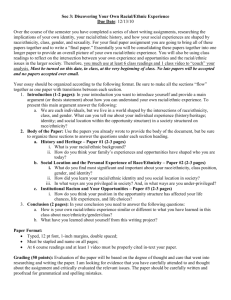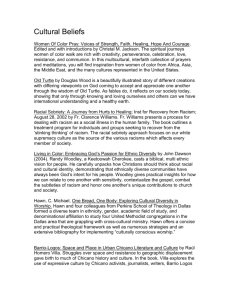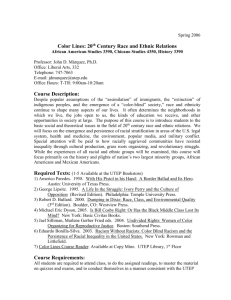SEMESTER AT SEA COURSE SYLLABUS
advertisement
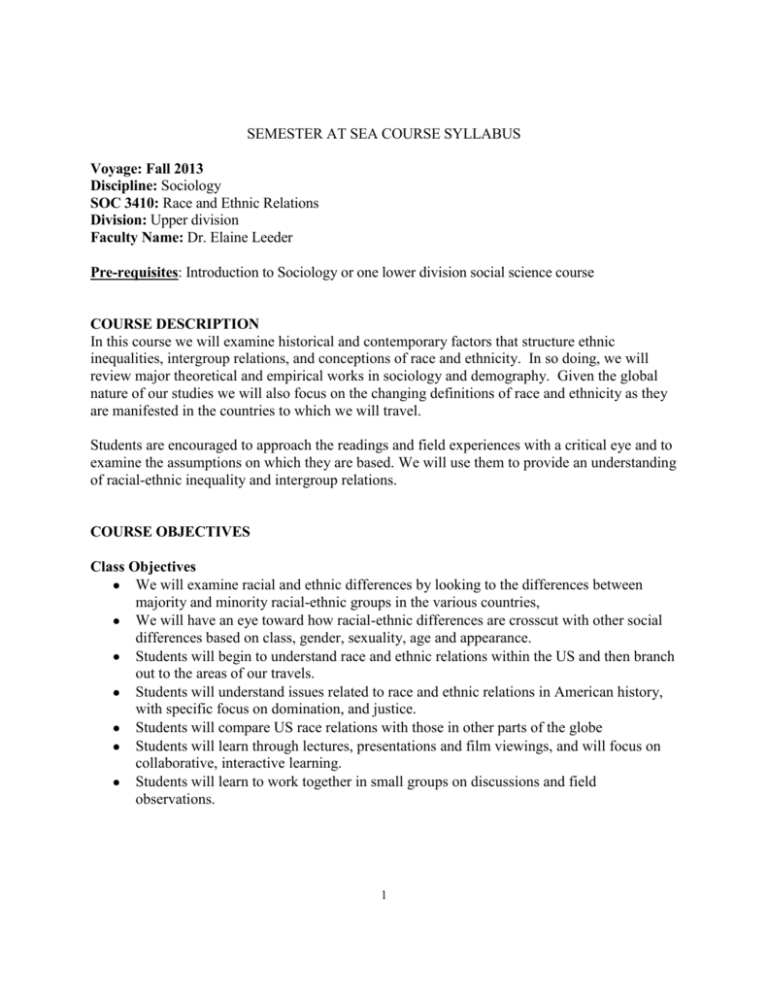
SEMESTER AT SEA COURSE SYLLABUS Voyage: Fall 2013 Discipline: Sociology SOC 3410: Race and Ethnic Relations Division: Upper division Faculty Name: Dr. Elaine Leeder Pre-requisites: Introduction to Sociology or one lower division social science course COURSE DESCRIPTION In this course we will examine historical and contemporary factors that structure ethnic inequalities, intergroup relations, and conceptions of race and ethnicity. In so doing, we will review major theoretical and empirical works in sociology and demography. Given the global nature of our studies we will also focus on the changing definitions of race and ethnicity as they are manifested in the countries to which we will travel. Students are encouraged to approach the readings and field experiences with a critical eye and to examine the assumptions on which they are based. We will use them to provide an understanding of racial-ethnic inequality and intergroup relations. COURSE OBJECTIVES Class Objectives We will examine racial and ethnic differences by looking to the differences between majority and minority racial-ethnic groups in the various countries, We will have an eye toward how racial-ethnic differences are crosscut with other social differences based on class, gender, sexuality, age and appearance. Students will begin to understand race and ethnic relations within the US and then branch out to the areas of our travels. Students will understand issues related to race and ethnic relations in American history, with specific focus on domination, and justice. Students will compare US race relations with those in other parts of the globe Students will learn through lectures, presentations and film viewings, and will focus on collaborative, interactive learning. Students will learn to work together in small groups on discussions and field observations. 1 REQUIRED TEXTBOOKS AUTHOR: Gallagher, Charles A. TITLE: Rethinking the Color Line: Readings in Race and Ethnicity PUBLISHER: McGraw Hill ISBN #: 978-0-07-802663-8 DATE/EDITION: 5th edition AUTHOR: Mark Mathabane TITLE: Kaffir Boy: The True Story of a Black Youth’s Coming of Age in Apartheid South Africa PUBLISHER: Free Press ISBN#: 0684848287 DATE/EDITION: 1986 TOPICAL OUTLINE OF COURSE A1: The Meanings of Race and Ethnicity Ch. 3. Omi, Michael and Howard Winant. “Racial Formations,” in Rethinking the Color Line Excerpts from The Difficult Difference: Race, Religion and the New Northern Ireland. Portland Oregon: Irish Academic Press. 2010 Ch. 15. Blumer, Herbert. “Race Prejudice as a Sense of Group Position.” In Rethinking the Color Line Ch. 17. Merton, Robert K. “Discrimination and the American Creed.” In Rethinking the Color Line Ch. 31. Kristin v. Aisha; Brad v. Rasheed: What’s in a Name and How It Affects Getting a Job” In Rethinking the Color Line A2: Discrimination and Racism; Prepare for Russia Ch. 16. Sterba, James. “Race and Gender Discrimination: Contemporary Trends Documentary: Race: the Power of an Illusion. The Differences Between Us. California Newsreel. 2003. A3: Colorblind America? Debrief Russia, Prepare for Germany 2 Ch. 12. Gallagher, Charles A. “Color Blind Privilege: The Social and Political Functions of Erasing the Color Line in Post-Race America.” Ch. 13. Gunier, Lani and Torres, Gerald, “The Ideology of Colorblindness” Ch. 14. Gans, Herbert. “The Possibility of a New Racial Hierarchy in the 21st Century United States” September 5-8: Hamburg, Germany A4 : Immigration: Documented and Undocumented; Preparation for Belgium and France Ch. 41. Stephen Steinberg. “The Melting Pot and the Color Line” and “Seeing the Big Picture: Who is Allowed to ‘Melt’ in the Pot? Who Wants To?” Ch. 18. Moustafa Bayoumi. “How Does it Feel to be a Problem?” “Minorities, Crime and Criminal Justice in Belgium” Pamela Irving Jackson in Minorities, Migrants and Crime: Diversity and Similarity across Europe and the US. Ineke Hael Marshal, editor. Thousand Oaks: Sage, 1997 (on reserve) September 12-14: Antwerp, Belgium September 15-16: LeHavre, France A5: Immigrants, Refugees, and the Shadow of the Homeland; Prepare for Ireland Ch. 44. Mary Waters. “Ethnic and Racial Identity of Second Generation Black Immigrants in NYC Ch. 44. “Seeing the Big Picture: Is a Nonethnic Racial Identity Possible?” Excerpts from Racism in the Irish Experience. Garner, S. London: Pluto Press, 2004 (on reserve) FIRST PORT OBSERVATION DUE September 20-23: Dublin, Ireland A6: Racial-Ethnic Identities and Experiences; Preparation for Portugal and Spain Ch. 29 Pager, Devah. “The Mark of a Criminal Record” Ch. 32. Waldinger, Roger. “When the Melting Pot Boils Over: The Irish, Jews, Blacks and Koreans of New York Racism: A Global Reader Reilly, Kaufman and Bodino. Armonk, NY: ME Sharpe, 2003; articles on racism in England and Spain; racism in US and South Africa (on reserve) 3 September 27-28: Lisbon, Portugal September 29: In transit September 30-October 1: Cadiz, Spain October 3-6: Casablanca, Morocco A7: Racial-Ethnic Identities and Experiences Reader: Abel Valenzuela Jr. and Elizabeth Gonzalez , “Latino Earnings Inequality: Immigrant and Native-Born Differences,” from Prismatic Metropolis. 2000. NY, NY: Russell Sage Foundation. Ch. 36 Dirks, Danielle and Jennifer Mueller. “Racism and Popular Culture” Handout of Race Construction in Morocco October 3-6: Casablanca A8: Racial-Ethnic Identities and Experiences: African Americans Ch. 22. Anderson, Elijah. “The Code of the Streets” Ch. 33. Newman, Katherine and Ellis, Catherine. “‘There’s No Shame in My Game’: Status and Stigma among Harlem’s Working Poor” Ch. 27. Alexander, Michelle. “The New Jim Crow” Ch. 28. Bobo, Lawrence and Victor Thompson. “Racialized Mass Incarceration: Rounding Up the Usual Suspects” A9: Racial-Ethnic Identities and Experiences: Native Americans Ch. 9. Wilkins, David. “A Tour of Indian Peoples and Indian Lands” Ch.39 Merskin, Debra.“Winnebagos, Cherokees, Apaches, and Dakotas: The Persistence of Stereotyping of American Indians in American Advertising Film: Reel Indians A10: Racial-Ethnic Identities and Experiences Film Amreeka, 2009. Directed by Cherien Dabis. In Class Midterm Exam October 13-16: Tema, Ghana A11: Racial-Ethnic Identities and Experiences: Asian Americans Ch.10. Espiritu, “Asian American Panethnicity: Bridging Institutions and Identities” 4 Ch. 34. Bao, Xiaolan, “Sweatshops in Sunset Park: A Variation of the Late Twentiety Century Chinese Garment Shops in New York City” A12: Racial-Ethnic Identities and Experiences: Preparation for South Africa Kaffir Boy, all Excerpts from McDonald, Michael. “Why Race Matters in South Africa” Harvard University Press, 2012 (on reserve) A13: Racial-Ethnic Identities and Experiences: Arab Americans Ch. 42. Suleiman, Michael. “The Arab Immigrant Experience.” Finish Kaffir Boy A14: Racial-Ethnic Identities and Experiences: Latinos/Latinas; More Prep for South Africa Kandel, William and Emilio Parrado. “Hispanics in the American South and the Transformation of the Poultry Industry” October 26-30: Cape Town, South Africa A15: Race and Romance Ch. 45. Dalmage, Heather M. “Discovering Racial Borders.” Ch. 44. Kennedy, Randall, “Captain Kirk Kisses Lieutenant Uhura: Interracial Intimacies—the View from Hollywood SECOND PORT OBSERVATION DUE A16: Race and Health Ch. 7. Shapiro, Thomas, “Transforming Assets: The Racial Wealth Gap and the American Dream Ch. 6. Williams, David and Michelle Sternthal, “Understanding Racial-Ethnic Disparities in Health Film” Black in Latin America: Brazil: A Racial Paradise? A17: Race, Immigration, and Gangs Film Sin Nombre, 2009. Directed by Cary Fukunaga. Reader: excerpt from Brazil’s New Racial Politics Reiten, Mitchell, editors, Boulder: Lynne Reinner Press, 2010 A18: Residential Segregation; Prepare for Argentina Ch. 21. Massey, Douglas S. “Residential Segregation and Neighborhood Conditions in U.S. Metropolitan Areas” 5 Ch. 25. Zenk, Shannon, “Why Are There No Supermarkets in My Neighborhood?: The Long Search for Fresh Fruit, Produce, and Healthy Food” November 12-15: Buenos Aires, Argentina A19: School Segregation and Higher Education Reader: The Growth of Segregation: African Americans, Latinos, and Unequal Education,” in The Structure of Schooling: Readings in the Sociology of Education, Gary Orfield pp. 194-206 THIRD PORT OBSERVATION DUE A20: School Segregation and Higher Education; Prepare for Brazil Reader: Affirmative Action: Diversity, Merit and the Benefit of White People Reader: “From the Polls: Affirmative Action. November 20-22: Rio deJaniero, Brazil A21: Gay Men Inequality Reader: Marcus Anthony Hunter, “All the Gays are White and all the Blacks are Straight: Black Gay Men, Identity, and Community.” Film: Race: the Power of an Illusion. The House We Live In. California Newsreel. 2003. A22: Wealth Inequalities Ch. 50 Gallagher, Charles. “Ten Simple Things You Can Do to Improve Race Relations” FOURTH PORT OBSERVATION DUE A23: Wealth Inequalities: Chapter 49 Lui, et al. “ Policy Steps toward Closing the Gap” A24: Wrap up – what have we learned about social inequality based on race and ethnicity A25: Final FIELD WORK: 6 In the course of this voyage a field assignment will be made for an eight hour experience required for the course. Students will be introduced to race/ethnic relations in the form of a visit to a community center for immigrants, school or university or lecture from an academic from a university in the port who is a specialist in race/ethnic relations. This professor is in the process of making such connections and will have this component arranged by the end of Fall, 2012. Goal: For students to see race and ethnic relations in operation in one specific port of call Activity and Measurement: The students will meet a specialist in the field and observe race relations in operation. Later they will write a 3-5 page paper on the assignment Percentage of grade: Twenty percent of the grade for this component FIELD LAB: It is the intent of this professor to arrange a field lab that will either be a visit to an immigrant community center in one of our ports or to a university where a professor who is knowledgeable on the subject will speak on race and ethnic relations in their country. FIELD ASSIGNMENTS: In the course of the voyage each student will also be required to do FOUR port observations on the nature of race/ethnic relations in that country. The students will be provided a field observation prompt outlining the suggested items for observation. The lenses will include intergroup relations and socialization, in group and out group interactions, gender relations related to race and ethnicity, age based racial and ethnic interactions and observations on intergroup conflict. Each observation will be worth 5 POINTS, for a total of 20 points. METHODS OF EVALUATION / GRADING RUBRIC Midterm Exam Final Exam Port Observations (4) Field Assignment (8 hours) Class Participation 20% 20% 20% 20% 20% 100% RESERVE LIBRARY LIST AUTHOR: Garner, S. TITLE: Racism in the Irish Experience PUBLISHER: London: Pluto Press DATE/EDITION: 2004 Ranked for purchase: 1. AUTHOR: Ineke Haen Marshall (editor) TITLE: Minorities, Migrants and Crime: Diversity and Similarity Across Europe and the US PUBLISHER: Sage DATE: 1997 Ranked for purchase:2 AUTHOR: Reilly, Kevin, S. Kaufman and Angela Bodino (editors) 7 TITLE: Racism: A Global Reader PUBLISHER: ME Sharpe DATE: 2003 Ranked for purchase: 3 AUTHOR: McDonald, Michael TITLE: Why Race Matters in South Africa PUBLISHER: Harvard University Press DATE: 2012 Ranked for purchase: 4 ELECTRONIC RESOURCES: Professor will provide copies to the library for scanning for a READER for the course Excerpts from The Difficult Difference: Race, Religion and the New Northern Ireland. Portland Oregon: Irish Academic Press. 2010 Excerpt from “The Changing Face of America: Immigration, Race/Ethnicity and Social Mobility,” by Zhou Min Excerpt from Leisy Abrego, “Legitimacy, Social Identity, and the Mobilization of Law: The Effects of Assembly Bill 540 on Undocumented Students in California Excerpts from “Straddling Different World: Acculturation of Vietnamese Refugee Children” by Zhou Min Excerpt from “Immigrant Parents and their Emigrant Adolescents: The Tension of Inner and Outer Worlds” by Mann, Mali Excerpt from “Latino Earnings Inequality: Immigrant and Native-Born Differences” from Prismatic Metropolis. By Valenzuela, Abel Jr. and Elizabeth Gonzalez. Russell Sage: 2000 Excerpt from Brazil’s New Racial Politics Reiten, Mitchell (editors). Lynne Reinner Press, 2010 Excerpt from “African American Males in Decline: A Los Angeles Case Study.” Johnson, James Jr., Walter Farrell Jr. and Jennifer Stoloff Excerpt from “All the Gays are White and all the Blacks are Straight: Black Gay Men, Identity and Community.” Marcus Anthony Hunter. Excerpt from “Overcoming Patriarchal Constraints: The Reconstruction of Gender Relations among Mexican Immigrant Women and Men” 8 Excerpt from “The Growth of Segregation: African Americans, Latinos and Unequal Education” in The Structure of Schooling: Readings in the Sociology of Education. Gary Orfield, pp. 194-206 Excerpt from “Affirmative Action: Diversity, Merit and the Benefit of White People” and “From the Polls: Affirmative Action” ADDITIONAL RESOURCES FILMS: Black in Latin America: Brazil-A Racial Paradise? Race: The Power of an Illusion: Differences Between Us; Race: The Power of an Illusion: The House We Live In. California Newsreel, 2003 Amreeka, 2009 Directed by Cherien Dabis Brick by Brick: A Civil Rights Story Reel Injun HONOR CODE Semester at Sea students enroll in an academic program administered by the University of Virginia, and thus bind themselves to the University’s honor code. The code prohibits all acts of lying, cheating, and stealing. Please consult the Voyager’s Handbook for further explanation of what constitutes an honor offense. Each written assignment for this course must be pledged by the student as follows: “On my honor as a student, I pledge that I have neither given nor received aid on this assignment.” The pledge must be signed, or, in the case of an electronic file, signed “[signed].” 9



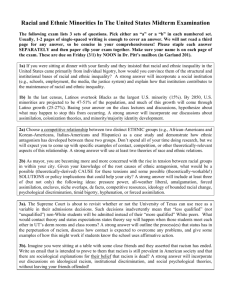
![[SOC 3AC] Niyogi F13 Midterm Exam](http://s3.studylib.net/store/data/008024599_1-cec01b60ef2f28fd40035e6e0b60c3ca-300x300.png)
